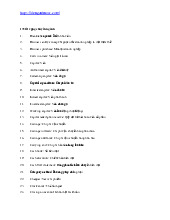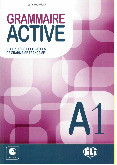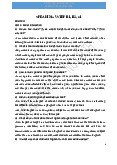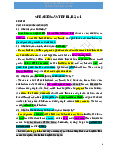


Preview text:
SPEAKING + WRITING
Topic 1: What are green activities and how do they benefit the environment? Write an essay of 140 -
180 words about it. (178 words)
Green activities refer to actions and practices that are environmentally friendly and promote
sustainability. These activities aim to lessen the negative impact of human actions on the environment and
preserve natural resources for future generations. One of the key benefits of green activities is the reduction
of carbon emissions. By adopting renewable energy sources such as solar or wind power, individuals and
businesses can significantly decrease their carbon footprint. This helps combat climate change and global
warming, which are major challenges. Another benefit is the conservation of natural resources. Green
activities encourage the efficient use of water and materials. It also promote biodiversity and protect
ecosystems. Preserving natural habitats, planting trees, and supporting sustainable agriculture, to maintain a
healthy balance in environment.
Furthermore, the contribution to improve air quality is considerable. We have to reduce pollution from
industries and vehicles, promoting clean transportation, and implementing proper waste management
practices. In conclusion, green activities play a crucial role in protecting the environment. Should we take on
green practices, we can create a sustainable future for ourselves and future generations.
Topic 2: Write an essay of 140 -180 words about advantages and disadvantages of using social networks (204 words)
Social networks have become an integral part of our daily lives, offering numerous advantages and
disadvantages. One of the key benefits is the ability to connect and communicate with people around the
world. Social networks provide a platform for individuals to share ideas, and opinions, fostering global
connections and cultural exchange. Anothers is the ease of access to information. Its allow users to stay
updated with current events, trends, or news. Thanks to social network, businesses and organizations can
promote their products or services, reaching a wider audience. Additionally, social networks offer
opportunities for professional growth by providing job searching and collaboration. Users can join groups
and communities based on their interests, knowledge and skills. However, social networks also have their
disadvantages. One major concern is privacy and security. Users need to be cautious about sharing personal
information and be aware of potential risks such as identity theft or cyberbullying. Besides, social networks
can be addictive, leading to excessive use and neglect of other important aspects of life. Users need to be
critical and verify the credibility of information before sharing or believing it. In conclusion, it is important
for users to use social networks responsibly and be aware of the potential risks involved. LISTENING Unit 4: The Mass Media
Nam: Congratulations, Lan! You've got an A on your English test!
Lan: Thanks, Nam. I should really thank a few social networking sites that help me to improve my English.
Nam: Sounds interesting! So how did you improve your English?
Lan: First, I registered and created an account with my nickname. Then I downloaded some free language
learning apps on my smartphone and started revising and learning new vocabulary on the go. I could practise
while on the bus on my way to school or while jogging in the park.
Nam: Wow! So you don't play online games anymore?
Lan: Of course I do, but I focus on language games such as Scrabble and crossword puzzles.
Nam: Really? I didn't know you were keen on these games. Aren't they boring?
Lan: Not if you connect and compete with other online gamers. You can also make friends and have fun.
Nam: Really? But you still need a tutor to explain things or correct your English if you make a mistake.
Lan: Exactly. Some social networking sites help you to connect with native speakers so you can ask
questions or have your writing drafts corrected.
Nam: Sounds good! I saw that you uploaded some vocabulary and grammar flashcards on all your social
media sites. How did you create them?
Lan: I used a free programme available on my smartphone. I also used the recording feature to collect
interesting samples from English TV and radio. Have you also seen my photos on my English blog?
Nam: Yes, I have. Great photos! Lan: Thanks. Unit 5: Cultural Identity
Singapore gained its independence on 9 August 1965 and now has a population of more than five million
people including Chinese, Malays, Indians and Eurasians. The country has four official languages: English,
Chinese, Malay and Tamil. Singapore does not have a national costume, as people from the different ethnic
groups tend to wear their traditional clothing.
The Chinese traditional attire for ladies is called cheongsam, which means a long garment. Originally,
both men and women used to wear this long, one-piece dress specially designed to conceal the body shape.
Today it's often worn by Chinese women in Singapore during Chinese New Year celebrations and at
traditional wedding ceremonies.
For Malay men, the traditional garment is called baju melayu. It consists of a loose shirt and a sarong
worn over a pair of trousers. Malay women often wear baju kurung, which looks like a long- sleeved and
collarless blouse worn over a long skirt.
The traditional dress for Indian women is thesari, which can be not only worn on special occasions, but
used every day. It's a long piece of brightly-coloured cloth wrapped around the waist and hung over the
shoulder. It's usually decorated with beautiful patterns.
Because of the hot temperatures and the modern character of Singapore, clothing is usually very casual
and most people prefer western fashions. For business, men usually wear dark trousers, white shirts and a
tie. Standard office attire for women includes a long-sleeved blouse with trousers or a skirt.
Unified by the common goal for a better future, the people of Singapore, especially the younger
generations, think of themselves as Singaporeans first, and then as Chinese, Malay or Indian.




